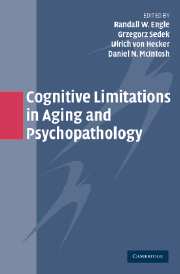Book contents
- Frontmatter
- Contents
- List of Contributors
- Preface
- Acknowledgments
- 1 Cognitive Limitations in Aging and Psychopathology: An Introduction and a Brief Tutorial to Research Methods
- SECTION I WORKING MEMORY AND COGNITIVE FUNCTIONS
- SECTION II AGING AND PSYCHOPATHOLOGY OF COGNITIVE CONTROL
- SECTION III ATTENTION, INHIBITION, AND REASONING PROCESSES
- Name Index
- Subject Index
- References
1 - Cognitive Limitations in Aging and Psychopathology: An Introduction and a Brief Tutorial to Research Methods
Published online by Cambridge University Press: 20 May 2010
- Frontmatter
- Contents
- List of Contributors
- Preface
- Acknowledgments
- 1 Cognitive Limitations in Aging and Psychopathology: An Introduction and a Brief Tutorial to Research Methods
- SECTION I WORKING MEMORY AND COGNITIVE FUNCTIONS
- SECTION II AGING AND PSYCHOPATHOLOGY OF COGNITIVE CONTROL
- SECTION III ATTENTION, INHIBITION, AND REASONING PROCESSES
- Name Index
- Subject Index
- References
Summary
After a brief presentation of this book's structure and the questions that served to organize the material, we describe the basic research paradigms used in the research from the various chapters. The essence of the theoretical models and the value of empirical evidence is best articulated by the authors of thematic chapters, so we do not summarize them here. However, we do not want arcane terminology or a lack of knowledge of the specific methods on the reader's part to prevent researchers outside of the area from understanding the ideas presented here. Therefore, to make the material more accessible to students and to researchers outside mainstream cognitive psychology, we offer a brief tutorial on the various methods.
At the outset of this project, we tried to preserve an integrative approach by explicitly asking each author to address the same questions. The following set of issues and questions was proposed to be addressed by all authors:
Question 1: Which cognitive functions are the focus of your research? In response to this question, authors either provided a description of their own original models of working memory or executive functions, or they elaborated on more specialized executive functions or processes such as inhibition, attention control, or reasoning that they investigated. Authors were asked to review in the general introduction of their chapter the most important theoretical approaches related to their own field before presenting their approach in detail.
- Type
- Chapter
- Information
- Cognitive Limitations in Aging and Psychopathology , pp. 1 - 16Publisher: Cambridge University PressPrint publication year: 2005



